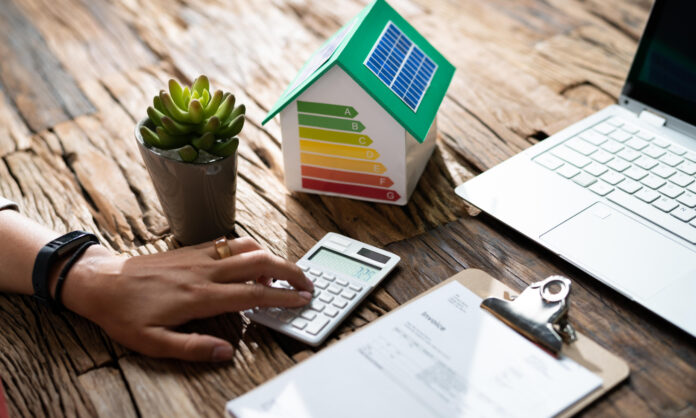Table of Contents
Disclaimer: Before reading this guidance, please remember that tax matters can be highly individualized and complex. EcoFlow does not provide any assurances or guarantees concerning potential tax credits that may be associated with our products. Any information we provide here in this guidance is solely for educational purposes and shall not be construed as legal advice. We recommend you rely on the expertise of tax professionals for accurate and personalized tax advice.
If you’re reading this article, you’re probably already aware of the 30% Federal Solar Tax Credit.
Officially known as the Residential Clean Energy Credit, it can save US taxpayers up to 30% of the total purchase and installation costs of a home solar panel system.
If you pay federal income tax and install an eligible renewable energy solution at your primary or secondary residence in the continental United States, you can save tens of thousands of dollars.
But how does the IRS verify solar credit eligibility?
Read on to find out!
Solar Tax Credits: A Brief Overview
The transition from burning fossil fuels to utilizing renewable energy sources like solar to power homes, transportation, and industry is an urgent global priority.
The adverse effects of greenhouse gas emissions on Earth’s climate and ecosystem are readily apparent from increased extreme weather events, shrinking biodiversity, and natural disasters like wildfires.
In an effort to encourage individuals to embrace solar power for electricity production, governments worldwide offer tax breaks, grants, and other incentives.
The Inflation Reduction Act of 2022 established numerous clean energy incentives in the United States, including the 30% Federal Solar Tax Credit.
Solar power isn’t the only renewable option eligible for the Residential Clean Energy Credit.
But for most homeowners and individuals, a photovoltaic (PV) solar system is by far the best option.
Not only are wind turbines and hydroelectric systems too cumbersome for most homes, but opting for solar panels also gives you access to state solar tax incentives.
Many cities and utility providers also offer solar incentives like grants and net metering.
If you opt for a grid-tied or hybrid solar panel system like EcoFlow DELTA Pro Ultra, net metering, if available in your location, gives you the option to sell electricity your system produces in excess of what you consume directly to the power company.
By maximizing your PV system’s electricity generation capacity, you can achieve solar payback more quickly.
Taking advantage of every available tax incentive and programs like net metering ensures you maximize your return on investment.
How Do Solar Tax Credits Work?
In the US, there are multiple solar tax credits available at every level of government.
Depending on where you’re installing your photovoltaic system, you may be eligible for federal, state, and local solar incentives.
The program that can save individual American taxpayers the most money, though, is the Residential Clean Energy Credit.
In the words of the Internal Revenue Service:
The Residential Clean Energy Credit equals 30% of the costs of new, qualified clean energy property for your home installed anytime from 2022 through 2032.
If you pay federal income tax and purchase an eligible clean energy solution, you should be able to deduct 30% of the total purchase cost — including installation — from your income tax liability using IRS Form 5695 when you file your return.

Solar Tax Credit Eligibility
So, are you eligible for the Federal Solar Tax Credit — officially known as the Residential Clean Energy Credit?
The answer is two-fold…
Are you personally eligible to use Form 5695?
And is the PV or other clean energy system eligible under IRS regulations?
Let’s dig in!
Personal Eligibility
If you pay federal income taxes in the United States, you’re almost guaranteed to be eligible for the Residential Clean Energy Credit.
Here are the requirements:
- You must purchase and install new photovoltaic modules (solar panels) or another qualified clean energy system for your primary home in the United States. Used, rented, and leased systems are not eligible.
- If you want to install a PV system at a secondary residence in the US, you must live there at least part-time. It can’t be a rental property.
- You must be a homeowner or renter. The credit is not available to landlords or other property owners who don’t reside on the premises.
- Only 20% of your home may be used for business purposes. If more than 20% of your residence is allocated for business use, the credit is based on the share of clean energy property purchase and installation expenses that are for personal use. For example, if 50% of your property is used for residential and the other 50% for business, only 50% of the system cost is eligible for the credit. Keep in mind that you may be better off claiming a clean energy credit for business.
- You must pay federal income tax in the year that you install the clean energy system. If you don’t owe any federal income tax that year, or your credit exceeds your liability, you can carry a credit balance forward and apply it to taxes owed in a future year.
- If you don’t pay federal income taxes, you won’t receive a credit.
The most common misconception about the Residential Clean Energy Credit is that it’s a tax rebate or a tax deduction.
It’s not.
It’s a non-refundable tax credit subtracted from the income tax you owe.
If you never owe or pay federal income taxes now or in the future, you won’t receive any government money towards clean energy property like solar panels and a balance of system — even if it meets the eligibility requirements explored in the next section.
However, if you owe federal income tax in the future, you can claim the costs of your clean energy property against that liability, even if you installed your PV system in a previous year.

System Eligibility
Photovoltaic solar panel systems aren’t the only type of “clean energy property” that meets the Residential Clean Energy Credit eligibility requirements.
According to the IRS, here are the eligible types of clean energy systems
- Solar electric panels
- Solar water heaters
- Wind turbines
- Geothermal heat pumps
- Fuel cells
- Battery storage technology (beginning in 2023)
Each system type is subject to additional requirements, such as electricity generation potential and storage capacity.
Here are the eligibility requirements for residential solar panel systems.
- The photovoltaic modules (solar panels) and balance of system must be installed at your US residence.
- Installation must take place between January 1, 2017, and December 31, 2034
- The solar PV system must be new or installed for the first time. Used systems don’t qualify.
- You must own the PV system. Solar panels and systems bought using direct from manufacturer financing may also be eligible, as long as you have a contract to purchase the system in full over time.
- The solar battery capacity in off-grid and hybrid PV systems must provide a minimum of 3kWh storage. For example, EcoFlow’s DELTA Pro solar generator provides 3.2kWh of capacity (expandable to 25kWh)

What Costs Does the Credit Cover?
Tax incentives and deductions can be highly restrictive. Many have strict eligibility requirements, dollar amounts, and limited frequency of use.
Not so with the Residential Clean Energy Credit.
There’s no limit on how much you can spend on your eligible system. Whether it’s $10,000 or $100,000, you can deduct 30% of the purchase and installation costs from your federal income tax liability.
There’s no cap on the number of times you can use the credit either — even in the same tax year.
Furthermore, there’s no restriction on combining the Federal Solar Tax Credit with state government or private incentives.
As long as you purchase the PV system for your home — and you pay income tax — you should be eligible.
But what exactly does the tax credit cover?
According to the IRS, an individual or household can claim 30% of the following expenses on Form 5695 as a tax credit.
Qualified solar electric property costs: Qualified solar electric property costs are costs for property that uses solar energy to generate electricity for use in your home located in the United States. No costs relating to a solar panel or other property installed as a roof (or portion thereof) will fail to qualify solely because the property constitutes a structural component of the structure on which it is installed. Some solar roofing tiles and solar roofing shingles serve the function of both traditional roofing and solar electric collectors, and thus serve functions of both solar electric generation and structural support. These solar roofing tiles and solar roofing shingles can qualify for the credit. This is in contrast to structural components such as a roof’s decking or rafters that serve only a roofing or structural function and thus do not qualify for the credit. The home doesn’t have to be your main home.
Qualified expenses may include labor costs for onsite preparation, assembly or original installation of the property and for piping or wiring to connect it to the home.
Regarding additional incentives:
When calculating your credit, you may need to subtract subsidies, rebates or other financial incentives from your qualified property expenses because they’re considered a purchase-price adjustment.
Public utility subsidies for buying or installing clean energy property are subtracted from qualified expenses. This is true whether the subsidy comes directly to you or to a contractor on your behalf. However, utility payments for clean energy you sell back to the grid, such as net metering credits, don’t affect your qualified expenses.
Rebates are subtracted from qualified expenses if all of these apply:
- The rebate is based on the cost of the property.
- It comes from someone connected to the sale such as the manufacturer, distributor, seller or installer.
- It isn’t given as payment for services you provide.
State energy efficiency incentives are generally not subtracted from qualified costs unless they qualify as a rebate or purchase-price adjustment under federal income tax law. Many states label energy efficiency incentives as rebates even though they don’t qualify under that definition. Those incentives could be included in your gross income for federal income tax purposes. Find more about how subsidies affect home energy credits.
To summarize, almost all, if not 100%, of your costs, should be eligible for the Federal Solar Tax Credit.
(Source: IRS)
Residential Clean Energy Credit (Form 5695): IRS Verification
Here’s some good news. Form 5695 is only 2.5 pages long and couldn’t be easier for you or your tax preparer to complete.
It covers the Residential Clean Energy Credit and the Energy Efficient Home Improvement Credit, as many taxpayers will be eligible for both.
Aside from filling out the form truthfully and accurately, there are no additional requirements, such as submitting proof of purchase, invoices, or receipts.
Your residential PV system or other clean energy property isn’t subject to routine physical inspection or additional verification prior to your credit being approved.
However, you must ensure that any clean energy property you claim for credit on Form 5695 meets the eligibility requirements — AND you must keep your receipts.
If you make a mistake on your taxes — including Form 5695 — you’ll likely face civil penalties such as fines and interest in addition to paying the taxes you actually owe.
Knowingly committing tax fraud — for example, by claiming a credit on Form 5695 for a PV system you didn’t actually purchase — can result in fines of up to $500,000 and up to five years in prison.

The Importance of Documentation and Record-Keeping
Filing a personal income tax return can be confusing, particularly if you claim expense deductions or a non-refundable tax credit like the Residential Clean Energy Credit.
For homeowners, property taxes add a whole other layer of complexity.
Most taxpayers who take multiple deductions and credits use a professional tax preparer such as an accountant or lawyer.
If you’re in doubt about whether you’re eligible for a tax credit, consult a professional. Even innocent mistakes can prove devastatingly costly.
Imagine purchasing clean energy property that turns out to be ineligible. You would have to pay for your PV system 100% out of pocket instead of having the government cover 30% of your costs. That mistake alone could cost tens of thousands of dollars.
Whether you hire a professional or TurboTax your returns yourself, it’s entirely your responsibility to preserve all the necessary documents to back up ANY claim you make to the IRS.
If you get flagged for an audit, you’ll be expected to produce detailed records and receipts for every claim. Typically, the IRS will notify you of an audit by mail, and an interview may be conducted in person.
If you cannot provide adequate documentation for your claims, the consequences can be severe — and even criminal.
In cases where tax fraud is suspected, an IRS criminal inspector may visit your home unannounced. Beware of scams, however. An IRS officer will never ask for money in person or over the phone. If an inspection does occur, tell the officer you want to contact a lawyer.
Don’t let any of the above scare you off from making a legitimate credit claim for eligible clean energy property like solar panels and a balance of system.
Request a certification from the manufacturer or installer of your PV electric system.
Manufacturer’s certification. For purposes of taking the credit, you can rely on the manufacturer’s certification, in writing, that a product is qualifying property for the credit. Don’t attach the certification to your return. Keep it for your records.
A reputable manufacturer or installer will happily provide you with the necessary documentation.
None of the above consequences of filing a false or erroneous return are unique to Form 5695 — they apply to any claims you make on your 1040 or other official tax documents.
The Residential Clean Energy Credit was made law to encourage honest taxpayers like you to start producing electricity using renewable energy sources.
Just follow the rules and keep your receipts.

Final Thoughts
Thanks to rapidly improving technology and generous government incentives, there’s never been a better time to switch to clean, renewable solar power for your home electricity needs.
Not only will you be doing your bit to reduce your family’s carbon footprint, but you’ll be making a wise investment in your financial future.
After all, once you pay off your residential solar panel system, all that money you save on electricity bills stays in your pocket.
High-efficiency, durable PV modules like EcoFlow’s rigid solar panels are perfect for rooftop installation.
You can connect up to 42 x EcoFlow 400W rigid solar panels to the DELTA Pro Ultra hybrid solar solution and produce more than enough electricity to power your whole home.
Unlike traditional grid-tied systems, hybrid solar solutions like EcoFlow DELTA Pro Ultra offer grid connectivity and energy security by combining solar + storage.
You can keep your house running during extended blackouts and take advantage of net metering when the grid is available. On-grid solar systems without storage don’t work during a blackout.
No matter what your clean energy needs, we’ve got a Federal Solar Tax Credit-eligible system for you.
Check out our award-winning selection today.
